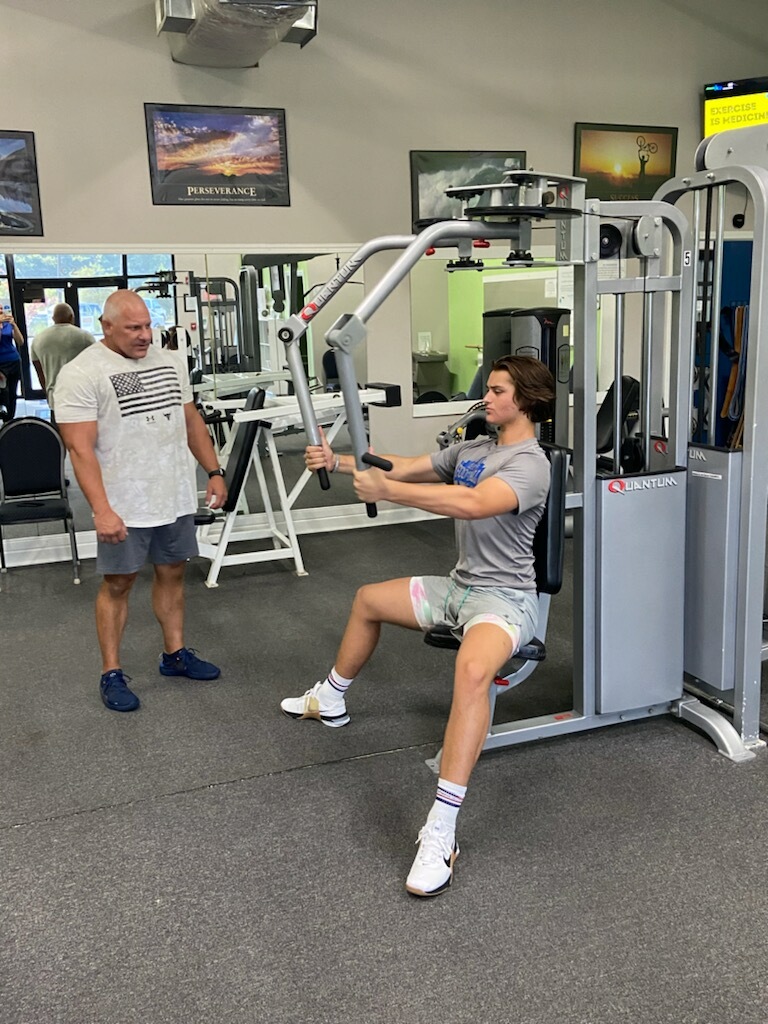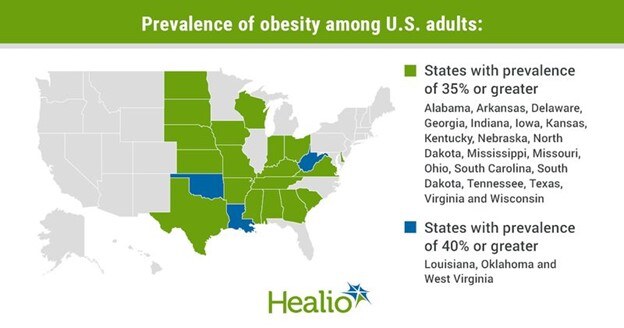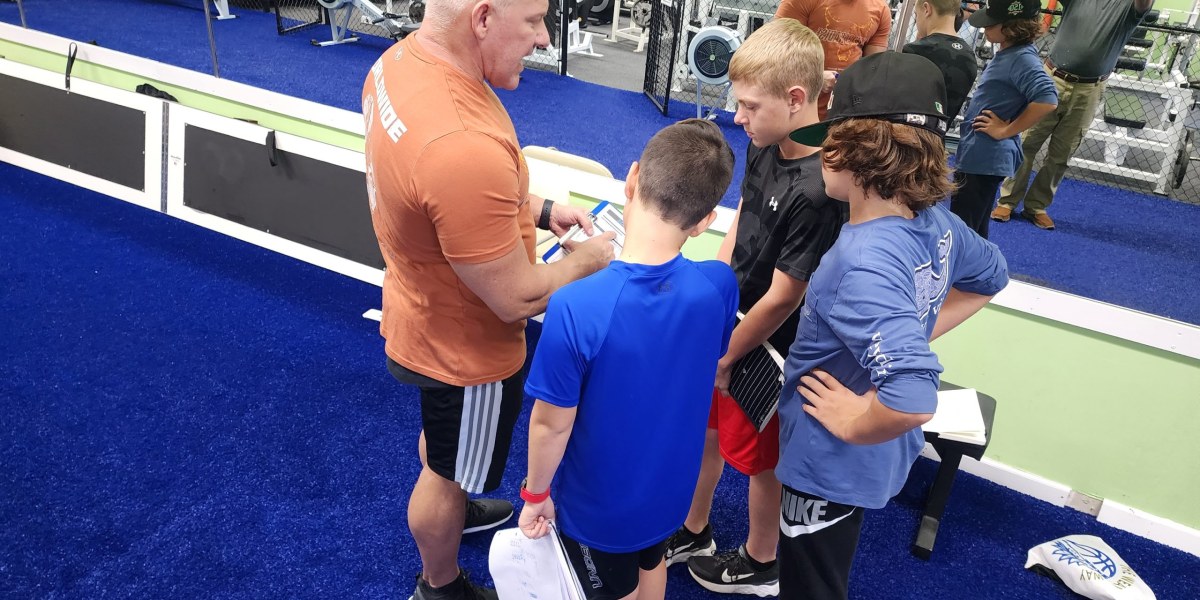Key takeaways:
- All states had an adult obesity prevalence exceeding 20%.
- Obesity prevalence differed based on race and ethnicity, and it was particularly high among Black adults.
According to CDC data, 22 states had an adult obesity prevalence of 35% or higher in 2022, up from 19 in 2021 and none in 2012.
“Our updated maps send a clear message that additional support for obesity prevention and treatment is an urgent priority,” Karen Hacker, MD, MPH, director of the CDC’s National Center for Chronic Disease Prevention and Health Promotion, said in a press release.
According to the CDC, the data underscore the need for population-based interventions and evidence-based health care services, like medications and surgery.
The 22 states with an adult obesity prevalence of 35% or higher include Alabama, Arkansas, Delaware, Georgia, Indiana, Iowa, Kansas, Kentucky, Louisiana, Mississippi, Missouri, Nebraska, North Dakota, Ohio, Oklahoma, South Carolina, South Dakota, Tennessee, Texas, Virginia, West Virginia, and Wisconsin.
Of those states, Louisiana, Oklahoma and West Virginia had a prevalence of 40% or greater. All states and territories had a prevalence higher than 20% — meaning, more than one in five adults have obesity.
The prevalence of obesity also varied heavily by race and ethnicity. The CDC found that among geographic groups with enough data — which included states, territories and Washington, D.C. — that had an adult obesity prevalence at or above 35% was:
- 38 (out of 48 states and Washington, D.C.) for Black adults;
- 33 (out of 47 states) for non-Hispanic American Indian or Alaska Native adults;
- 32 (out of 49 states, two territories and Washington, D.C.) for Hispanic adults;
- 14 (out of 49 states, one territory and Washington, D.C.) for non-Hispanic white adults; and
- zero (out of 37 states, one territory and Washington, D.C.) for non-Hispanic Asian adults.
Additionally, adults aged 45 to 54 years had the highest obesity prevalence among all age groups (39.9%), whereas adults aged 18 to 24 years had the lowest (20.5%).
Hacker explained that because obesity is caused by several factors like physical activity levels, dietary patterns, certain medications and genetics, “there is no one size fits all approach” to addressing the problem.
“However, we know the key strategies that work include addressing the underlying social determinants of health such as access to health care, healthy and affordable food, and safe places for physical activity,” she said.
References:
- Adult obesity prevalence remains high; support for prevention and treatment needed. https://www.cdc.gov/media/releases/2023/p0922-adult-obesity.html. Published Sept. 21, 2023. Accessed Sept. 29, 2023.
- CDC. Adult obesity prevalence maps. https://www.cdc.gov/obesity/data/prevalence-maps.html. Updated Sept. 21, 2023. Accessed Sept. 29, 2023.
As early as middle school, training focuses on how kids can best move their bodies

Training can begin in middle school, focused on basic running, jumping and landing mechanics. Make sure the intensity is right for your child’s age and skill level.
When kids get active in sports or training, the benefits are clear. They’ll build self-esteem, get better grades, develop leadership skills and form friendships. This is in addition to the great physical health benefits they’ll reap.
There can be downsides. Too much training or competition can be stressful, especially for young kids.
It’s possible for your child to experience the good without the bad.
Where to begin
Introduce your child to a sport and intensity level that’s age- and skill-appropriate.
Training can begin in middle school. At first, kids should focus on learning how to use their bodies. Start with practicing basic running, skipping, jumping and landing mechanics.
Avoid pressuring them to choose a single sport to focus on too early. Children should play a variety of sports to develop a strong foundation of athletic skills. When they pick a primary sport, this foundation can make them a better and healthier overall athlete.
Choosing a sport and training program
Pay attention to cues from your child about what they want. As a teen, they may want to focus on one or two sports. You can provide encouragement and even help them find a specialized training program for their sport of choice.
If your child is interested in a training program, do your homework. Your child’s training program should be based on best practices and research, not guesswork.
Find a program with a team that has all the right certifications and experience. Young athletes should learn techniques based on scientific principles and backed by national organizations.
These programs should also be designed around your child’s specific needs. Look for programs that test athletes before and after the training program, such as Alpha Athletics. This shows kids exactly what they’ve accomplished.
When to take a step back
If your child seems overwhelmed, it might be time to take a different path, either temporarily or permanently. Pushing too hard can cause burnout and puts kids at a higher risk of injury.
Variety can help prevent burnout and stress. In the off-season, introduce a different activity that complements their chosen sport. For example, football players get great benefits from yoga.
The bottom line is children aren’t small adults. To keep your child happy and healthy, pay attention to their behavior and talk to them about how they’re feeling. Make sure they know it’s OK to feel overwhelmed and ask for a break.
FOR IMMEDIATE RELEASE
The Fitness Zone Receives 2023 Best of Little River Award
Little River Award Program Honors the Achievement
LITTLE RIVER September 27, 2023 — The Fitness Zone has been selected for the 2023 Best of Little River Award in the Fitness Center category by the Little River Award Program.
Each year, the Little River Award Program identifies companies that we believe have achieved exceptional marketing success in their local community and business category. These are local companies that enhance the positive image of small business through service to their customers and our community. These exceptional companies help make the Little River area a great place to live, work and play.
Various sources of information were gathered and analyzed to choose the winners in each category. The 2023 Little River Award Program focuses on quality, not quantity. Winners are determined based on the information gathered both internally by the Little River Award Program and data provided by third parties.
About Little River Award Program
The Little River Award Program is an annual awards program honoring the achievements and accomplishments of local businesses throughout the Little River area. Recognition is given to those companies that have shown the ability to use their best practices and implemented programs to generate competitive advantages and long-term value.
The Little River Award Program was established to recognize the best of local businesses in our community. Our organization works exclusively with local business owners, trade groups, professional associations and other business advertising and marketing groups. Our mission is to recognize the small business community’s contributions to the U.S. economy.
SOURCE: Little River Award Program
CONTACT:
Little River Award Program
Email: PublicRelations@businesshonorlocal.com
URL: http://www.businesshonorlocal.com
###





Recent Comments